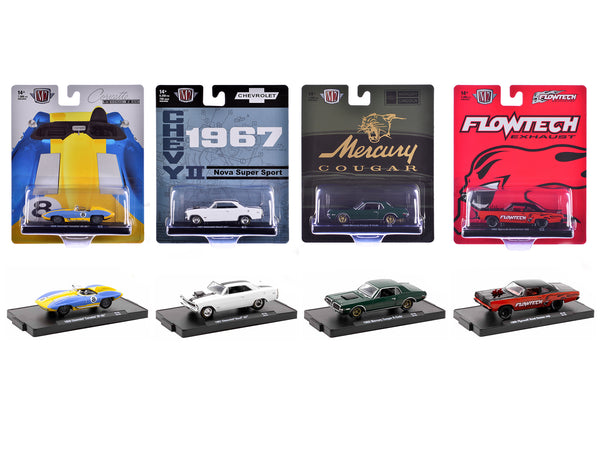
Why the Ferrari F40 Remains a Collector's Dream in the World of Supercars and Italian Sports Cars
Related Products
Share
The Ferrari F40 remains an iconic symbol in the world of supercars and Italian sports cars, captivating car enthusiasts and collectors alike with its unparalleled blend of history and performance. Introduced in 1987 to celebrate Ferrari's 40th anniversary, the F40 was the last car personally approved by Enzo Ferrari, marking a significant moment in automobile history. Its groundbreaking design and engineering set new benchmarks for Ferrari performance, earning it a revered status among automotive aficionados. In this exploration, we will delve into the F40's history, examining how its legacy continues to influence modern supercars and why it remains a collector's dream.
The Legacy of the Ferrari F40
Birth of an Icon
The Ferrari F40 emerged from a desire to create a superlative sports car that would pay homage to Ferrari's storied history while pushing the boundaries of automotive engineering. Launched in 1987, the F40 was conceived as a high-performance machine with minimal frills, embodying the spirit of raw power and agility. It was designed during a time when automotive manufacturers were exploring the potential of turbocharging technology, and Ferrari leveraged this to create a racing-inspired vehicle fit for the road. The F40's bold, aerodynamic shape was crafted by Pininfarina, an iconic design house, which contributed to its immediate recognition in the realm of Italian sports cars. With a twin-turbocharged V8 engine producing 471 horsepower, the F40 set new standards for Ferrari performance. This blend of innovation and heritage solidified its status as an icon, leaving an indelible mark on automobile history.
F40 History and Milestones
The Ferrari F40's history is marked by significant milestones that underscore its legendary status. Born from the vision of Enzo Ferrari, the F40 was developed to celebrate the company's 40th anniversary, symbolizing a pinnacle of Ferrari's engineering prowess. Its debut was met with widespread acclaim, as it became the fastest, most powerful, and most expensive model Ferrari had ever produced at the time. Only 1,311 units were manufactured between 1987 and 1992, making it an exclusive and highly coveted vehicle among collectors. The F40 was also notable for being the first road car to break the 200 mph barrier, a groundbreaking achievement that elevated Ferrari performance to new heights. Its influence extended beyond its production run, as the F40 served as a benchmark for future supercars. This enduring legacy has secured its place in the annals of automobile history, maintaining its allure among car enthusiasts worldwide.
Influence on Supercars and Italian Sports Cars
The Ferrari F40 has left a lasting imprint on the design and engineering of supercars and Italian sports cars. Its introduction marked a paradigm shift, showcasing how performance could be maximized through a focus on lightweight construction and aerodynamic efficiency. The F40's emphasis on using advanced materials like carbon fiber and Kevlar set a new standard that influenced subsequent supercar designs, emphasizing strength without added weight. Additionally, its minimalist interior focused on the driving experience, encouraging a return to the essence of what made sports cars exciting: the connection between driver and machine. This philosophy resonated with car manufacturers, prompting them to prioritize the balance of power, agility, and design in their future models. The F40's impact is evident in the development of subsequent Ferrari models and inspires contemporary Italian sports cars, ensuring its principles continue to shape the evolution of high-performance vehicles in the modern era.
Design and Engineering Marvels
Aerodynamics and Aesthetics
The Ferrari F40's design is a testament to the harmonious blend of aerodynamics and aesthetics, capturing the essence of speed and style. Every curve and contour of the F40 was meticulously crafted with performance in mind, resulting in a shape that is both functional and visually striking. The low, wide stance and prominent rear spoiler are key aerodynamic features that enhance stability and downforce at high speeds, contributing to its exceptional Ferrari performance. The design team at Pininfarina ensured that the F40's aggressive appearance also communicated its racing pedigree, making it instantly recognizable among supercars. The use of lightweight materials like carbon fiber not only reduced weight but also allowed for a sleek, uncluttered design, emphasizing the F40's focus on raw performance. This seamless integration of form and function set a new benchmark for Italian sports cars, cementing the F40's status as a design and engineering marvel in automobile history.
Engine and Performance Specs
At the heart of the Ferrari F40 lies a formidable engine that defines its outstanding performance. The F40 is powered by a 2.9-liter twin-turbocharged V8 engine, a groundbreaking configuration at the time of its release. This powerhouse generates an impressive 471 horsepower and 426 lb-ft of torque, allowing the F40 to accelerate from 0 to 60 mph in just 4.2 seconds. With a top speed exceeding 200 mph, the F40 was a trailblazer in the realm of supercars, setting benchmarks for Ferrari performance that few could match. The engine's responsiveness and raw power are complemented by a five-speed manual transmission, providing a visceral driving experience that prioritizes the connection between car and driver. The F40's performance specs showcase Ferrari's commitment to engineering excellence, blending cutting-edge technology with racing heritage. This combination of power, speed, and engineering precision is a key factor in the F40's enduring appeal among enthusiasts and collectors alike.
Innovations in Automobile History
The Ferrari F40 stands out as a beacon of innovation in automobile history, introducing technologies and design philosophies that have since become industry standards. One of its most significant contributions was the extensive use of lightweight materials, such as carbon fiber and Kevlar, which not only enhanced performance but also paved the way for their adoption in future high-performance vehicles. The F40's aerodynamic design, characterized by its distinctive rear wing and streamlined body, was a precursor to the aerodynamic principles that guide modern supercar design. Additionally, the implementation of a twin-turbocharged engine in a production car demonstrated Ferrari's commitment to pushing engineering boundaries. This focus on innovation extended to the F40's minimalist interior, which emphasized the importance of driver engagement and connection. These groundbreaking advancements helped redefine what was possible in a road car, influencing the development of both supercars and Italian sports cars for generations to come.
Performance on the Road and Track
Ferrari Performance Benchmarks
The Ferrari F40 set unprecedented performance benchmarks that defined its legacy on both road and track. A key contributor to its exceptional capabilities was its power-to-weight ratio, achieved through a combination of a potent twin-turbocharged V8 engine and a lightweight chassis. This configuration allowed the F40 to deliver blistering acceleration, with 0 to 60 mph reached in just 4.2 seconds, and a top speed of over 200 mph. These figures were trailblazing at the time, establishing new standards for supercars. On the racetrack, the F40's agility and raw power translated into impressive handling and cornering abilities, making it a formidable competitor. Its performance dynamics were further enhanced by innovative suspension systems and precise steering, characteristics that continue to inspire Ferrari performance benchmarks today. The F40's success was not just in its numbers, but in how it translated engineering prowess into a thrilling driving experience that remains unmatched.
Racing Achievements and Accolades
The Ferrari F40's illustrious racing career is a testament to its outstanding performance capabilities. Though primarily designed as a road car, the F40's inherent agility and power quickly found success on the track. It participated in various motorsport events, including the prestigious IMSA GT series, where it showcased its prowess against dedicated race cars. The F40 achieved notable victories, earning accolades for its speed and handling. Its racing variants, such as the F40 LM and F40 Competizione, further pushed the boundaries of performance, incorporating enhancements that heightened its track capabilities. These successes not only cemented the F40's reputation in racing circles but also highlighted Ferrari's engineering excellence. Beyond its trophies, the F40's legacy in motorsport lies in its influence on Ferrari's approach to blending road and race technology, setting a standard that would inform future generations of supercars and affirming its place in automobile history.
Real-World Driving Experience
Driving the Ferrari F40 is an immersive experience that captivates enthusiasts with its raw power and unfiltered engagement. Unlike modern supercars equipped with electronic aids, the F40's design emphasizes direct driver involvement, offering an authentic connection to the vehicle. The absence of power steering and traction control demands a skilled touch, rewarding those who appreciate precision and responsiveness. The F40's twin-turbo V8 engine delivers a surge of power, accompanied by a visceral soundtrack that enhances the thrill of acceleration. Its minimalist cockpit, stripped of luxuries, focuses entirely on the joy of driving, with clear instrumentation and supportive seating. On the road, the F40's lightweight construction and aerodynamic design provide exceptional handling, allowing it to navigate curves with agility and confidence. This unadulterated driving experience, coupled with its performance pedigree, ensures the F40 remains a cherished icon among those seeking an exhilarating journey on both road and track.
The Collector's Perspective
Market Value and Rarity
The Ferrari F40 holds a unique position in the collector car market, prized for its rarity and historical significance. With only 1,311 units produced between 1987 and 1992, the F40's limited availability makes it a highly sought-after treasure among collectors. This exclusivity, coupled with its status as the last Ferrari personally approved by Enzo Ferrari, boosts its market value significantly. Over the years, the F40 has seen its worth appreciate, often commanding prices well into the millions at auction. Beyond its monetary value, the F40's appeal lies in its embodiment of Ferrari's engineering prowess and legacy. It represents a turning point in automobile history, where performance met artistry. Collectors are not only drawn to its investment potential but also to its iconic design and exhilarating driving experience. This blend of factors ensures that the Ferrari F40 remains a coveted masterpiece, cherished by both seasoned collectors and automotive enthusiasts alike.
Ownership and Maintenance
Owning a Ferrari F40 is a prestigious endeavor that comes with its own set of challenges and responsibilities. As a collector's item, maintaining the F40 requires a commitment to preserving its condition and performance, necessitating specialized care and expertise. Due to its advanced engineering and use of unique materials, servicing an F40 often involves sourcing original parts and skilled technicians familiar with its specific needs. Regular maintenance is crucial to ensure the car operates at its peak, including routine checks on its turbocharged engine, suspension components, and carbon fiber bodywork. Additionally, proper storage conditions are essential to protect it from environmental factors that could degrade its materials over time. While the cost of ownership can be substantial, many collectors view it as a worthwhile investment in automotive history. The pride and satisfaction of possessing such an iconic vehicle, coupled with the joy of driving or displaying it, make the Ferrari F40 a cherished addition to any collection.
Community and Enthusiast Culture
The Ferrari F40 has fostered a passionate community of enthusiasts and collectors who celebrate its legacy and impact on the world of supercars. This vibrant culture is centered around a shared appreciation for the F40's history, design, and driving experience. Owners and admirers often gather at events such as car shows, track days, and dedicated Ferrari meet-ups, where they can share their experiences and showcase their prized vehicles. These gatherings provide an opportunity to connect with like-minded individuals who value the F40's significance in automobile history. Online forums and social media groups further enhance this sense of community, offering platforms for discussions, restoration tips, and sharing the latest news about the F40 market. Enthusiasts are united by a deep respect for this iconic Italian sports car, and their collective enthusiasm helps preserve its legacy for future generations. This enduring community ensures that the Ferrari F40 remains not just a car, but a celebrated symbol of performance and innovation.
Future of the Ferrari F40
Long-term Investment Potential
The Ferrari F40's long-term investment potential is a key consideration for collectors and investors alike. As a classic supercar with a limited production run, the F40's rarity enhances its desirability and value over time. Its historical significance as the last Ferrari overseen by Enzo Ferrari further cements its status as a valuable asset. Market trends have consistently shown an appreciation in the F40's value, often outpacing traditional investment vehicles. This trend is likely to continue as the demand for iconic collector cars remains strong. The F40's appeal is not solely based on its monetary value; it also represents a cultural icon in the automotive world, admired for its engineering excellence and design. For investors, owning an F40 is an opportunity to preserve a piece of automotive history while potentially benefiting from its appreciating value. As such, the Ferrari F40 remains a wise investment for those seeking both financial returns and a connection to motoring heritage.
Comparisons with Modern Supercars
When compared to modern supercars, the Ferrari F40 stands out for its raw, unadulterated driving experience. Unlike contemporary vehicles that often rely on advanced electronics and driver aids, the F40 offers a pure connection between driver and machine. Its manual steering and lack of traction control demand skill and engagement, contrasting with the highly automated systems found in today's supercars. While modern vehicles boast superior technology, acceleration, and comfort, the F40's charm lies in its simplicity and focus on performance fundamentals. Its lightweight design and turbocharged V8 engine remain benchmarks for power-to-weight efficiency, a testament to its engineering brilliance. Furthermore, the F40's design and legacy as an icon of the late 20th century continue to captivate enthusiasts. While modern supercars may surpass it in technical prowess, the Ferrari F40's enduring appeal lies in its representation of a bygone era of automotive purity and innovation.
Preservation of a Legend
Preserving the Ferrari F40 is about more than just maintaining a vehicle; it's about safeguarding an icon of automotive history. Enthusiasts and collectors take meticulous care to ensure these cars remain in pristine condition, often employing specialists in restoration and maintenance to uphold their original specifications. Given the F40's use of advanced materials and technology for its time, preservation involves attention to detail, from the integrity of its carbon fiber bodywork to the functionality of its turbocharged engine. The cultural significance of the F40 motivates owners to participate in shows, exhibitions, and concours events, where these vehicles are celebrated and shared with the public. This dedication helps maintain the F40's legacy and ensures future generations can appreciate its impact on the world of supercars and Italian sports cars. By preserving the F40, enthusiasts not only honor Ferrari's storied past but also inspire continued innovation and passion in the automotive community.





